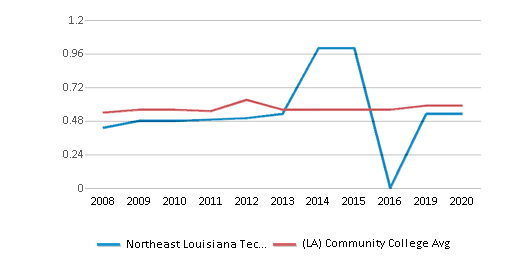- The Louisiana Technical College (LTC) delivers instructional programs which provide skilled employees for business and industry that contribute to the overall economic development and workforce needs of the state. The LTC provides individuals with quality and relevant learning opportunities consistent with identified student and business and industry needs within a life-long learning environment.
School Highlights
Northeast Louisiana Technical College served 1,215 students (55% of students were full-time).
The college's student:teacher ratio of 12:1 was lower than the state community college average of 23:1.
Minority enrollment was 44% of the student body (majority Black), which was less than the state average of 60%.
School Overview
Northeast Louisiana Technical College
(LA) Community College Avg.
Carnegie Classification
Associates Colleges
Associates Colleges
Institution Level
Less than 2 yrs
At least 2 but less than 4 years
Institution Control
Public
Public
Total Faculty
98 staff
37 staff

Student Body
Total Enrollment
1,215 students
422 students

Student : Teacher Ratio
12:1
23:1

# Full-Time Students
665 students
311 students

# Part-Time Students
550 students
393 students



# Enrollment Undergraduate
n/a
343 students
# Full-Time Undergraduate Students
1,215 students
284 students

# Full-Time Graduate Students
n/a
17 students
# Part-Time Undergraduate Students
550 students
1,213 students
# Part-Time Graduate Students
n/a
1 students
Total Dormitory Capacity
n/a
217 students
% American Indian/Alaskan
1%
1%

% Asian
1%
2%

% Hispanic
2%
5%

% Black
40%
41%

% White
56%
40%

% Hawaiian
n/a
1%
% Two or more races
n/a
2%
% Non Resident races
n/a
1%
% Unknown races
n/a
7%


Diversity Score
0.53
0.66

College Completion Rate (Students who graduate in less than 4 years)
58%
48%

College Completion Rate (Students who graduate in 4 years or more than 4 years)
n/a
0.3147%
Average Graduate Earnings (10 Years)
$31,100
$31,100

Tuition and Acceptance Rate
% Students Receiving Some Financial Aid
83%
90%

Median Debt for Graduates
n/a
$12,567
Median Debt for Dropouts
n/a
$5,500
Acceptance Rate
n/a
94%
ACT Composite
n/a
21
ACT English
n/a
21
ACT Math
n/a
20
Source: 2020 (or latest year available) Integrated Postsecondary Education Data System (IPEDS) , School Administrators
School Notes
- Louisiana Technical College provides statewide technical and vocational education and is composed of seven districts with forty campuses, each consisting of a multicultural population encompassing much diversification in the way of ideas, traditions, values, skills, and arts. This college is governed by the Louisiana Community and Technical College System (LCTCS) Board of Supervisors, which in turn comes under regulations set forth by the Louisiana Board of Regents for Higher Education. The Louisiana Technical College works closely with local and statewide industry to bring the latest training programs to our students. Each campus offers customized training programs. The Accrediting Commission of the Council on Occupational Education (COE) accredits each individual campus of the Louisiana Technical College.
Recent Articles

Obtaining Your Bachelor's Degree at a Community College
Explore the evolving landscape of community colleges offering bachelor's degrees, addressing affordability, accessibility, and workforce needs.

A to Z of Community College Certificates and Courses
From business and healthcare to technology and skilled trades, the article showcases the breadth of options available to students seeking to enhance their knowledge, develop new skills, or pursue career advancement.

What is a Community College?
This comprehensive guide explains what a community college is, its history, and its role in higher education. It covers the types of programs offered, differences from four-year colleges, benefits of attending, and important considerations for prospective students, providing valuable insights for those exploring educational options.





